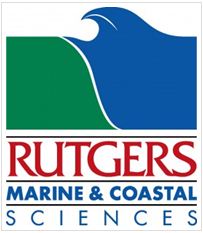Gulf Of Mexico
The Gulf of Mexico is located at the south eastern corner of North America bordered by Mexico, Texas, Louisiana, Mississippi, Alabama, and Florida. It has a surface area of 1.5 million km2 and marine shoreline of 5,700 km from the tip of the Yucatan to Cape Sable in Florida. Water enters the Gulf through the Yucatan Strait, circulates as the Loop Current, and then exits through the Florida Strait eventually forming the Gulf Stream. Portions of the Loop Current often break away forming eddies or 'gyres' which affect regional current patterns. Drainage into the Gulf of Mexico is extensive and includes 20 major river systems. Annual freshwater inflow to the Gulf is approximately 10.6x1011 m3 per year. 85% of this flow comes from the United States, with 64% originating from the Mississippi River alone.
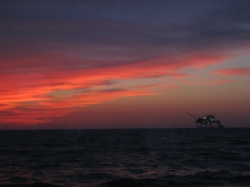
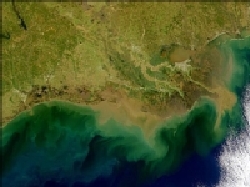
The most infamous "dead zone" develops in the Gulf of Mexico each summer, threatening fisheries. This dead zone is an area of anoxic and hypoxic water thought to develop because an excess of nitrogen from farm fertilizers, sewage and emissions from vehicles and factories enters the gulf predominately via the Mississippi River. A "nitrogen cascade" results as nitrogen flows untreated into the gulf and triggers the proliferation of plankton, which in turn depletes oxygen in the water. While fish might flee this suffocation, slow moving, bottom-dwelling creatures like clams, lobsters and oysters are less able to escape. Hypoxia in the Gulf of Mexico coincides with water column stratification, high salinities, and poor mixing. These physical processes interact with the biological processes responding to eutrophication across large spatial scales (4000 to 24,000 km2).
Current Projects
Gulf of Mexico Ecosystems and Hypoxia Assessment: Mechanisms Controlling Hypoxia (MCH) Project
PI: Dr. Steve DiMarco with Oceanography, Texas A&M University, College Station. NGOMEX - NOAA Coastal Ocean Program.
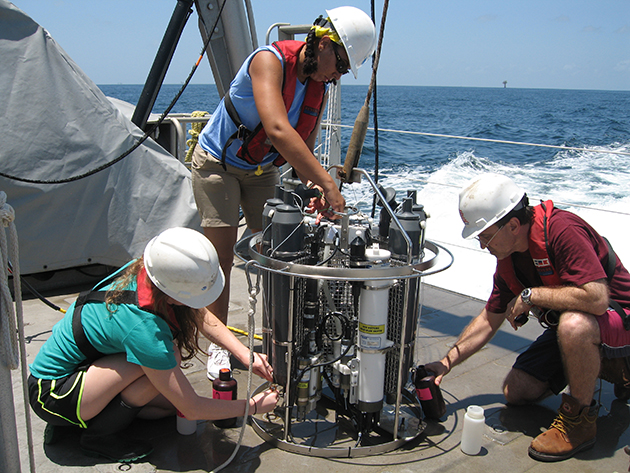
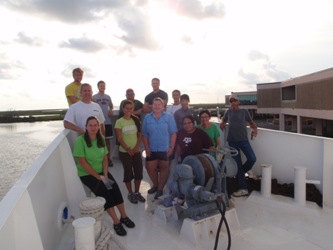
The processes that control and maintain the hypoxic zone in this region are complex and their relative strengths are known to vary temporally and spatially. Although close to the Mississippi River Delta, hypoxia is thought to be driven by biological processes, further downstream, the dominant controlling processes are mostly physical. Currents and winds combine to break down the vertical stratification necessary to sustain the low dissolved oxygen. Because the eastern region of the shelf (between 91°W and 89°W) is almost always hypoxic in mid-summer, it is likely that variability of the western region (between 91°W and the TX border), that largely controls the total size of the hypoxic area in a given year. Therefore, understanding the interactions of the physical, biological, and geochemical processes on the western shelf is critical for a comprehensive description of the mechanisms that control hypoxia. An integrated, multidisciplinary study of the TX-LA Shelf was conducted which targeted process-oriented high spatial resolution hydrographic surveys, multidisciplinary moored observations, and a coupled model to examine small (10 km) temporal and spatial scales of variability of hypoxia.
A comprehensive list of publications and other resources can be found at: http://hypoxia.tamu.edu/
Bianchi, T.S., Garcia Tigreros, F., Yvon-Lewis, S., Shields, M., Mills, H., Butman, D., Osburn, C., Raymond, P., Shank, C., DiMarco, S. F., Walker, N., Reese, B., Mullins, R., Quigg, A., Aiken, G.R., and Grossman, E. 2013. Enhanced Transfer of Terrestrially-Derived Carbon to the Atmosphere in a Flooding Event. Geophysical Research Letters. 40: 1-7.
Nunnally, C.C.; Rowe, G.T.; Thornton, D.C.O., and Quigg, A. 2013 Sedimentary oxygen consumption and nutrient regeneration in the Gulf of Mexico hypoxic zone. In: Brock, J.C.; Barras, J.A., and Williams, S.J. (eds.), Understanding and Predicting Change in the Coastal Ecosystems of the Northern Gulf of Mexico, Journal of Coastal Research Special Issue 63: 84–96.
Zhao, Y., Wang, Y. and Quigg, A. 2015 Comparison of population growth and photosynthetic apparatus changes in response to different nutrient status in a diatom and a coccolithophore. Journal of Phycology. 51: 872-884.DOI: 10.1111/jpy.12327
Zhao, Y. , Wang, Y. and Quigg, A. 2015 The 24 hour recovery kinetics from N starvation in Phaeodactylum tricornutum and Emiliana huxleyi. Journal of Phycology. 51: 726-738. DOI: 10.1111/jpy.12314.
Zhao, Y. and Quigg, A. Study of photosynthetic productivity in The Northern Gulf of Mexico: importance of diel cycles and light penetration. Continental Shelf Research. 102: 33-46. DOI: 10.1016/j.csr.2015.04.014
Chekalyuk, A., Barnard, A., Quigg, A., Hafez, M. and Zhao, Y. 2014 Aquatic Laser Fluorescence Analyzer: Field evaluation in the Northern Gulf of Mexico. Optics express. 22 (18), 21641-21656.
Nunnally, C.C., DiMarco S.F., Quigg, A., Chapman, O., Rowe, G.T. 2014 Benthic-Pelagic Coupling in the Gulf of Mexico Hypoxic Area: Sedimentary enhancement of eutrophic conditions and near bottom primary production. Continental Shelf Research. 85: 143-152. DOI: 10.1016/j.csr.2014.06.006
Zhao, Y. and Quigg, A. 2014 Nutrient limitation in Northern Gulf of Mexico (NGOM): phytoplankton communities and photosynthesis respond to nutrient pulse. PLOS One. 9(2): e88732. DOI:10.1371/journal.pone.0088732
Recent Projects
Seasonal Mapping of Productivity and Nutrient Limitation
PI: Dr. Jim Ammerman of the New York Sea Grant and Dr. Jason Sylvan of the University of Southern California.

The objective of this study was to map surface primary productivity and nutrient limitation in the Mississippi Plume and the Louisiana shelf several times during the high flow period in the spring and early summer. Primary productivity will be mapped using a Fast Repetition Rate (FRR) Fluorometer and nutrient limitation will be mapped by measurement of cell-surface enzyme activities and nutrients. These productivity measurements will be compared with satellite remote sensing of phytoplankton pigments as well as shipboard bicarbonate uptake measurements. We expect predominantly phosphorus limitation during this time period so the major enzyme activity to be measured will be alkaline phosphatase, though enzymes responsive to nitrogen limitation will also be measured. Many measurements will be made continuously underway with automated instruments in real time, though discrete samples will also be analyzed.
Sylvan, J. B., Quigg, A., Tozzi, S. and Ammerman, J.W. 2011. Mapping phytoplankton community physiology on a river impacted continental shelf: testing a multifaceted approach. Estuaries and Coasts. 34: 1220-1233.
Quigg, A.,Sylvan, J. B., Gustafson, A. B., Fisher, T. R., Tozzi, S. and Ammerman, J. W. 2011. Going west: Phosphorus limitation of primary production in the Northern Gulf of Mexico and the importance of the Atchafalaya River. Aquatic Geochemistry. 17: 519-544.
Sylvan, J. B., Quigg, A., Tozzi, S. and Ammerman, J.W. 2007 Eutrophication induced phosphorus limitation in the Mississippi River Plume: Evidence from fast repetition rate fluorometry. Limnology and Oceanography. 52: 2679-2685.
Th(IV) and Pa(IV,V) Binding to exopolymeric acid and polysaccharides in the marine environment
PI: Dr. Peter Santschi with Marine Science, Texas A&M University at Galveston NSF - Chemical Oceanography Program.

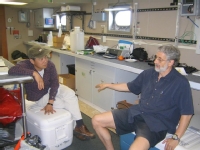
Th(IV) and Pa(IV,V) isotopes are important proxies in oceanographic investigations. Even though almost routine, these approaches rely on often poorly constrained, empirically determined and variable isotope ratios or ratios to POC. Previously conducted laboratory and field investigations suggest that Th(IV) removal could be controlled through binding by exopolymeric acid polysaccharide (APS) rich biomolecules, potentially produced by both phytoplankton and bacteria. We hypothesize that Pa(V) present in ocean water must first be reduced to Pa(IV) by organic biomolecules before efficient binding to solid phases can occur. We further propose that the most efficient binding would occur to APS-rich biomolecules produced by phytoplankton species such as diatoms, prymnesiophytes and cyanobacteria. The program investigated possible fractionation mechanisms between Pa(IV.V) and Th(IV) in the ocean. Laboratory studies consist of uptake experiments to a number of substrates, including purified APS harvested from phytoplankton and bacterial cultures to be used in Th(IV) and Pa(IV,V) binding assessments. The most important analytical task will be to better characterize, both chemically, in terms of molecular composition, and physically, in terms of surface activity, the newly discovered strongly Th(IV) complexing APS of %7e13 kDa molecular weight, found in particulate and colloidal material collected from the Gulf of Mexico, Atlantic and Pacific Ocean and the South China Sea. The proposed field program included collection and extraction of diverse types of organic matter for use in laboratory studies, as well as the determination of temporal and spatial variations of radiochemical and biochemical parameters.
Xu,C., Santschi,P.H., Hung,C.-C.,Zhang,S., Schwehr,K, A., Roberts,K.A., Guo, L.,Gong, G.-C., Quigg, A., Long, R. A., Pinckney, J., Duan, S.W., Amon, R., and Wei, C-L. 2011. Controls of Th-234 removal from the oligotrophic ocean by polyuronic acids and modification by microbial activity. Marine Chemistry. 123: 111-126.
Hung, C-C., Xu,C., Santschi, P. H., Zhang, S-J., Schwehr, K. A., Quigg, A., Guo, L., Gong, G-C., Pinckney, J., Long, R.A., and Wei, C-L. 2010. Evaluation of the POC and 234Th fluxes in the Gulf of Mexico from sediment traps and size-fractionated POC/234Th ratios in suspended particles. Marine Chemistry. 121: 132-144.




